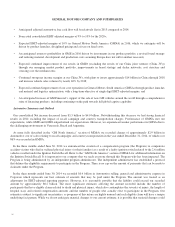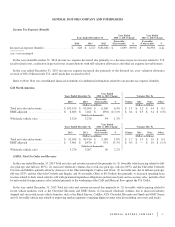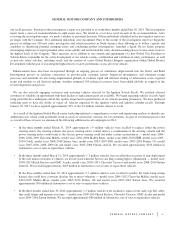General Motors 2014 Annual Report Download - page 38
Download and view the complete annual report
Please find page 38 of the 2014 General Motors annual report below. You can navigate through the pages in the report by either clicking on the pages listed below, or by using the keyword search tool below to find specific information within the annual report.GENERAL MOTORS COMPANY AND SUBSIDIARIES
GMNA EBIT-Adjusted
The most significant factors which influence GMNA’s profitability are industry volume (primarily U.S. seasonally adjusted annual
rate) and market share. While not as significant as industry volume and market share, another factor affecting profitability is the
relative mix of vehicles (cars, trucks, crossovers) sold. Variable profit is a key indicator of product profitability. Variable profit is
defined as revenue less material cost, freight, the variable component of manufacturing expense, and policy and warranty expense.
Vehicles with higher selling prices generally have higher variable profit. Trucks, crossover vehicles and cars sold in the U.S. currently
have a variable profit of approximately 160%, 90% and 40% respectively of our portfolio on a weighted-average basis.
In the year ended December 31, 2014 EBIT-adjusted decreased due primarily to: (1) unfavorable Other of $5.0 billion due primarily
to an increase in recall campaign actions and recall related charges of $2.3 billion, increased material and freight costs including new
launches of $2.8 billion, and increased engineering expense of $0.5 billion, partially offset by increased daily rental vehicles sold with
guaranteed repurchase obligations and reduced advertising expenses; partially offset by (2) favorable vehicle pricing related to full-
size pick-ups and full-size SUVs; (3) increased wholesale volumes due to full-size pick-ups, full-size SUVs and the Chevrolet
Colorado, Corvette and Malibu, partially offset by decreases of the Chevrolet Impala, Captiva and Cruze; and (4) favorable mix due to
full-size pick-ups, full-size SUVs and the Chevrolet Corvette and Impala.
In the year ended December 31, 2013 EBIT-adjusted increased due primarily to: (1) favorable vehicle pricing related to recent vehicle
launches such as the Chevrolet Silverado and GMC Sierra; and (2) increased wholesale volumes due to increased industry demand and
successful recent vehicle launches such as the Buick Encore, Cadillac ATS and Chevrolet Silverado; partially offset by (3) unfavorable
Other of $1.4 billion due primarily to increased material and freight costs including new launches of $1.1 billion, increased
manufacturing expense including new launches of $0.3 billion, increased engineering expense of $0.3 billion and increased depreciation
and amortization expense of $0.2 billion, partially offset by a reduction in unfavorable warranty and policy adjustments of $0.6 billion.
Recall Campaigns
In the year ended December 31, 2014 we experienced a significant increase in the number of vehicles subject to recall in North
America resulting in incremental charges for the estimated costs of parts and labor to repair these vehicles and courtesy transportation
for certain recalls. There were approximately 36 million vehicles subject to recalls announced during this period. This included
approximately 10 million vehicles subject to multiple recalls and reflects the results of our ongoing comprehensive safety review,
additional engineering analysis and our overall commitment to customer satisfaction.
In the three months ended March 31, 2014 we announced a recall to repair ignition switches in vehicles that we are no longer
producing that under certain circumstances could result in a loss of electrical power that may prevent front airbags from deploying in the
event of a crash. It was originally estimated that approximately 800,000 vehicles were equipped with ignition switches needing repair.
These vehicles include model years 2005–2007 Chevrolet Cobalt, 2007 Pontiac G5 and 2005–2006 Pursuit. In the three months ended
December 31, 2013 we recorded approximately $40 million in Automotive cost of sales to cover the repairs as these costs were
considered probable and estimable at that time. In the three months ended March 31, 2014 we expanded this recall by approximately
1.8 million additional vehicles for the same issue. These vehicles, consisting of model years 2008–2010 Chevrolet Cobalt, model years
2006–2011 HHR, model years 2008–2010 Pontiac G5, model years 2006–2010 Solstice, model years 2003–2007 Saturn ION and model
years 2007–2010 Sky, were not included in the initial recall. In the three months ended March 31, 2014 we recorded approximately $90
million in Automotive cost of sales to repair these vehicles and approximately $270 million in Automotive cost of sales to provide
courtesy transportation to owners of affected vehicles. These recalls, relating to ignition switches, are collectively referred to as the
“Ignition Switch Recall.” Refer to Note 17 to our consolidated financial statements for litigation associated with the Ignition Switch
Recall. A second repair was added to these vehicles as a result of the comprehensive review described below to fix ignition lock cylinders
that could allow removal of the ignition key while the engine is running, leading to possible rollaway or crash. In the three months ended
March 31, 2014 we recorded approximately $320 million in Automotive cost of sales to repair ignition lock cylinders.
In response to these developments we conducted an in-depth review of the Ignition Switch Recall and our overall recall processes. We
hired a former U.S. Attorney to conduct an internal investigation of the Ignition Switch Recall and to provide recommendations to improve
38
























